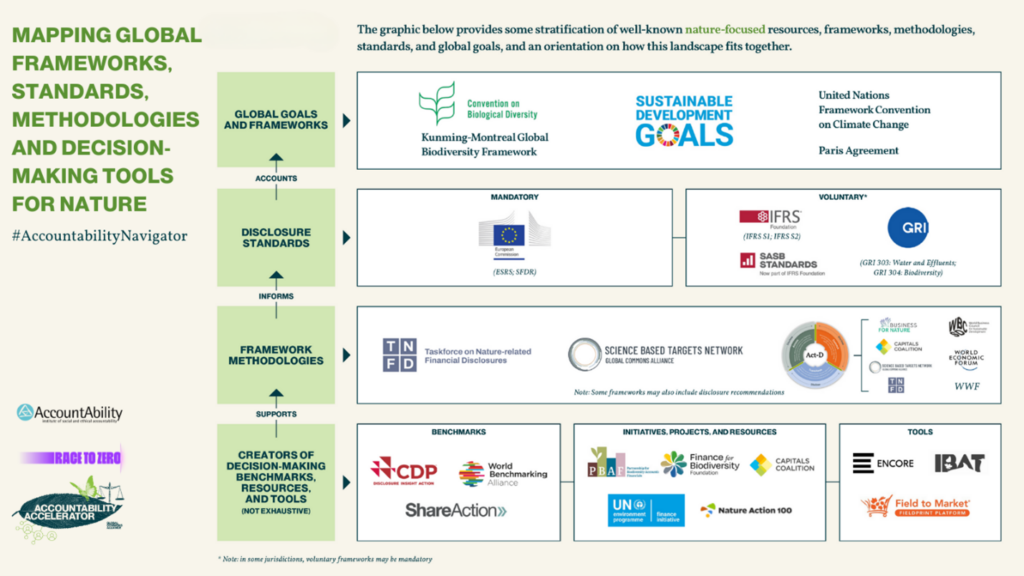Integrate Nature-Positive Strategies
Environmental Defense Fund
Corporate performance and accountability systems are emerging to support and catalyze credible and impactful business action on nature. Your company can be prepared to respond to current and future climate and nature standards and reporting requirements by integrating nature-positive strategies into your climate plan.

Climate & Nature Transition Planning
Creating a climate transition action plan is essential for businesses strategizing and implementing their net zero commitments. To effectively integrate nature, your company should design or reassess its climate transition strategy, identifying opportunities where net zero and nature actions align—maximizing positive impacts for the climate, ecosystems, and human well-being. An integrative transition plan should start with the most cost-effective, easily achievable solutions.
The World Business Council for Sustainable Development (WBSCD), Science Based Targets for Nature (SBTN), Taskforce on Nature-related Financial Disclosures (TNFD), the World Economic Forum, and Capitals Coalition have teamed up to help businesses address nature-related challenges. They introduced a framework called ACT-D (Assess, Commit, Transform, and Disclose) to guide businesses in taking actions to halt and reverse nature loss. In addition, SBTN’s guidance outlines a practical five-step approach to set science-based targets for nature. TNFD has developed an integrated approach called LEAP (Locate, Assess, Evaluate, Prepare) to identify and assess nature-related risks. Additionally, the Nature and Climate Resource Navigator is a practical tool for companies navigating the complex voluntary and regulatory landscape of frameworks, tools, and guidance. Below is a map of climate and nature resources that are available to drive accelerated action and impact.

Each step below draws from these existing and emerging frameworks (primarily ACT-D, SBTN, and TNFD) and recommendations to help your company kick-start and/or advance your climate and nature journey.
Summarized High-Level Recommendations to Kick-Start or Build Upon Your Climate and Nature Journey
| Recommendation | Description |
| Step 1: Assess and Reduce Impact | Conduct a materiality screening and create a comprehensive emissions inventory to identify where business activities interact with nature and assess material dependencies, impacts, risks, and opportunities. |
| Step 2: Set Science-Aligned Targets | Establish precise, time-bound, science-aligned targets to mitigate priority impacts on nature and climate, aiming for net zero emissions and nature recovery by 2050 or sooner. |
| Step 3: Take Action & Engage Stakeholders | Collaborate with stakeholders to implement integrated climate and nature strategies to reduce current impacts, avoid future impacts, and regenerate and restore ecosystems. |
| Step 4: Report and Disclose | Prepare disclosures by creating responses to material issues, strategies, action plans, and risk management processes to achieve targets. Transparently report progress against commitments and compliance with evolving disclosure |
Key Recommendations to Support Your Climate & Nature Journey
Step 1: Assess and reduce your impact on nature and climate through materiality screenings and emissions accounting.
A materiality screening allows your business to identify most material nature-related issues that your company’s targets and associated actions should address. Materiality screenings are the first step for you to identify priority areas that can feed into your corporate materiality assessment and inform credible target setting and priority actions to halt and reverse nature loss; it should include experts and your company’s internal and external stakeholders.
Companies further along on their journey can perform a screening to ensure all priority areas are covered. The Corporate Sustainability Reporting Directive (CSRD), SBTN, and TNFD all require companies to complete a materiality screening.
| Framework Alignment | |
| ACT-D | Assess In ACT-D’s “assess” phase, companies should use SBTN guidance to identify and manage priority environmental impacts, dependencies, and locations, build upon initial materiality assessments, and evaluate risk and opportunities using the Nature Capital Protocol and TNFD. |
| SBTN | Steps 1a and b (Assess) SBTN’s Technical Guidance for Step 1 – Assess guides companies on conducting a materiality screening and estimating pressures on nature associated with their business operations. When completing Step 1, see SBTN’s Data Needs Summary and Toolbox |
| TNFD LEAP | Locate, Evaluate, Assess The LEAP (Locate, Assess, Evaluate, Prepare) guidance by TNFD outlines a four-step process for companies to identify their portfolios’ exposure to nature-related issues. It also includes recommended resources and methods for assessing risks, such as scenario analysis and heat mapping. |
Step 2: Identify and prioritize actions to avoid and reduce negative impacts and promote opportunities to restore and regenerate nature. Establish science-aligned, time-specific targets and indicators for reducing priority impacts on nature, including short and long-term emission reduction goals aiming for net zero by 2050 or sooner.
Once an initial materiality assessment has been completed, your company can prioritize its impacts and actions to inform realistic, meaningful, credible commitments, targets, and actions at both the impact driver and company response levels. Engaging and securing the buy-in of affected stakeholders will be crucial in setting your nature targets.
To set measurable science-aligned targets, a further assessment is required to collect data, establish baseline data for priority land and seascapes with stakeholders, align with planetary boundaries, track progress, and report. Third-party stakeholders should validate targets and associated action plans.
| Framework Alignment & Resources | |
| ACT-D | Commit ACT-D’s “Commit” phase recommends that companies set transparent, time-bound, specific, science-based targets to put their company on the right track toward operating within the Earth’s limits and leverage resources from the SBTN and Accountability Framework Initiative. |
| SBTN | Step 2 (Interpret and Prioritize) The Technical Guidance for Step 2 – Prioritize helps companies determine which locations and economic activities to include within their target boundaries and where to take action to mitigate their most significant negative impacts on nature effectively. |
| TNFD LEAP | Prepare: TNFD’s Guidance on Response Metrics in the Prepare Phase of LEAP guides assessment metrics for responses to nature-related dependencies, impacts, risks, and opportunities relevant to the Prepare phase of the LEAP approach. |
Step 3: Take action & engage with stakeholders to bridge nature-related risks and opportunities into climate-related engagements, build a deep understanding of broader portfolio risks and opportunities, and scale solutions.
Collective action is critical for businesses, the public sector, and civil society to share lessons, pool resources, and develop collaborative initiatives. Your company should ensure C-level integration by embedding climate and nature objectives within the top-level strategy, including research and limiting global warming to well below 2 degrees and doing everything possible to avoid increases in devastating storms, droughts, fires, and severe other climate impacts.
Your company should also engage in landscape-level and jurisdictional approaches to collaborative action to reduce impacts such as deforestation, land conversion, and local community distress. It should aim to produce positive changes through contextually appropriate investments in nature-based solutions. Finally, it should champion supportive nature-positive campaigns, policies, funding, and infrastructure.
| Framework Alignment | |
| ACT-D | Transform: ACT-D’s “Transform” phase suggests companies contribute to systems transformation: avoid and reduce negative impacts, restore and regenerate, shift business strategy and models, advocate for policy ambition, and offer several tools and resources to engage. |
| SBTN | Step 4 (Act): SBTN developed the AR3T Action Framework (AR3T 356), which consists of four actions: “Avoid,” “Reduce,” “Regenerate and Restore,” and “Transform (Step 4).” The framework aims to help companies avoid negative impacts on nature, reduce current impacts, regenerate and restore ecosystems, and positively transform their systems. SBTN also released its Stakeholder Engagement Guidance (v1.0.1) to support organizations engaging with their stakeholders throughout Steps 1-5 of the SBTN framework. It provides principles and frameworks to help organizations identify key stakeholders and outlines why and how organizations should engage with them when setting targets. |
| TNFD | TNFD’s Guidance on Engagement with Indigenous Peoples, Local Communities (IPLCs), and Affected Stakeholders also provides organizations with instructions on engaging with IPLCs and affected stakeholders. It emphasizes the importance of adhering to international standards, guidelines, and frameworks while identifying, assessing, and managing nature-related risks, opportunities, dependencies, and impacts. |
Step 4: Report and disclose progress against your commitments, targets, and actions. This reporting should be transparent, credible, and comparable and adhere to the emerging regulatory and voluntary disclosure requirements and frameworks.
Nature-related disclosures are essential for your company to communicate its efforts toward positive environmental outcomes. These disclosures will contribute to the achievement of GBF Target 15, which requires businesses to assess, disclose, and reduce biodiversity-related risks and negative impacts. Voluntary and mandatory accountability mechanisms will require these disclosures.
Although your company may opt to only partially align with all TNFD disclosure recommendations in the short term, you should start making initial disclosures now and transparently acknowledge any gaps. Initial disclosures can include methodologies and outputs of materiality assessments, value chain mapping, interim target-setting, and progress on actions. TNFD’s reporting framework provides “core” and “enhanced” disclosures across the four pillars of disclosure to support your business at any stage of its journey.
| Framework Alignment | |
| ACT-D | Disclose: In the “disclose phase,” companies are recommended to track performance and prepare to publicly report material nature-related information throughout their journey using resources including TNFD, GRI, and CDP to align reporting major standards. |
| SBTN | Measure, set, disclose (Step 3), Track (Step 5): SBTN has released technical guidelines on nature for organizations to “Measure, Set, & Disclose Targets” for freshwater (v1.1) and land (v1) and ocean (v1). In the future, SBTN plans to provide target-setting technical guidelines for biodiversity, guidance for taking action (SBTN Step 4), and tracking impact against targets (SBTN Step 5). |
| TNFD | TNFD Reporting Framework Pillars TNFD’s Disclosure Recommendations contain a specific disclosure requirement for all sectors to report on metrics and targets. Where there is no TNFD sector guidance, organizations may refer to industry best practices and guidance from organizations such as GRI or SASB. |
The current climate and nature crises require economic transformation, and a recognition that environmental issues are material to core business operations. Your company must also prepare for emerging nature-related regulations. By building on existing climate efforts—including, but not limited to, reducing emissions from land use change and eliminating deforestation, reducing the impact of land management, and investing in resilient supply chains with active participation of affected stakeholders, you can take action now to create an integrated nature-positive strategy that benefits your business, the climate, and people.